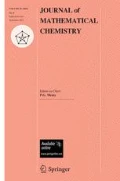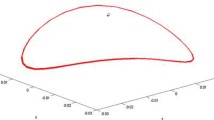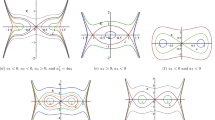Abstract
In this paper, complete analysis is presented to study Bautin bifurcation for the Lengyel–Epstein System
Sufficient conditions for \(a\) and \(b\) are given for the system to demonstrate Bautin bifurcation. By using \(b\) and \(\alpha =a/5\) as bifurcation parameters and computing the first and second Lyapunov coefficients and performing nonlinear transformation, the normal form with unfolding parameters is derived to obtain the bifurcation diagrams such as Hopf and double limit cycle bifurcations. An example is given to confirm that the system has two limit cycles.



Similar content being viewed by others
References
V. Castets, E. Dulos, J. Boissonade, P. De Kepper, Experimental evidence of a sustained standing Turing-type nonequilibrium chemical pattern. Phys. Rev. Lett. 64, 2953–2956 (1990)
I.R. Epstein, I. Lengyel, Turing structures progress toward a room temperature, closed system. Phys. D Nonlinear Phenom. 84, 111 (1995)
O. Jensen, V.O. Pannbacker, E. Mosekilde, G. Dewel, P. Borckmans, Turing structures and turbulence in a chemical reaction-diffusion system. Open Syst. Inf. Dyn. 3, 215–235 (1995)
Y. Kuznetsov, Elements of Applied Bifurcation Theory, 3rd edn. (Springer, New York, 2004)
I. Lengyel, I.R. Epstein, Global bifurcation and structure of Turing patterns in the 1-D Lengyel–Epstein model. Sciences 251, 650–652 (1991)
I. Lengyel, I.R. Epstein, A chemical approach to designing Turing patterns in reaction-diffusion system. Proc. Natl. Acad. Sci. USA 89, 3977–3979 (1992)
I. Lengyel, G. Ribai, I.R. Epstein, Experimental and modeling study of oscillations in the chlorine dioxide-iodine-malonic acid reaction. J. Am. Chem. Soc. 112(25), 9104–9110 (1990)
N. Li, L. Shi, X. Wang, F. Guo, C. Yan, Experimental study of closed system in the chlorine dioxide-iodide-sulfuric acid reaction by UV–Vis spectrophotometric method. Int. J. Anal. Chem. (2011). doi:10.1155/2011/130102
D.G. Míguez, S. Alonso, A.P. Munũzuri, F. Sagués, Experimental evidence of localized oscillations in the photosensitive chlorine dioxide-iodine-malonic acid reaction. Phys. Rev. Lett. 97, 178301 (2006)
W. Ni, M. Tang, Turing patterns in the Lengyel–Epstein system for the CIMA reaction. Trans. Am. Math. Soc 357, 3953–3969 (2005)
Q. Ouyang, V. Castets, J. Boissonade, J.C. Roux, P. De Kepper, Sustained patterns in chlorite-iodide reactions in a one-dimensional reactor. J. Chem. Phys. 95, 351–360 (1991)
F. Yi, J. Wei, J. Shi, Diffusion-driven instability and bifurcation in the Lengyel–Epstein system. Nonlinear Anal. RWA 9, 1038–1051 (2008)
Author information
Authors and Affiliations
Corresponding author
Rights and permissions
About this article
Cite this article
Wu, X.P., Eshete, M. Bautin bifurcation for the Lengyel–Epstein system. J Math Chem 52, 2570–2580 (2014). https://doi.org/10.1007/s10910-014-0401-6
Received:
Accepted:
Published:
Issue Date:
DOI: https://doi.org/10.1007/s10910-014-0401-6
Keywords
- Lengyel–Epstein System
- Bautin bifurcation
- First and second Lyapunov coefficients
- Normal forms
- Hopf and double limit cycle bifurcations




